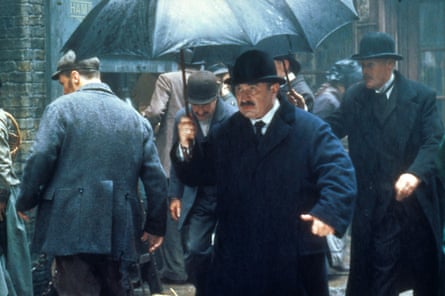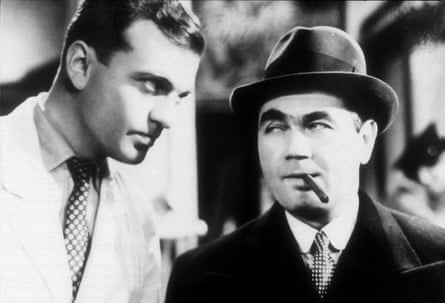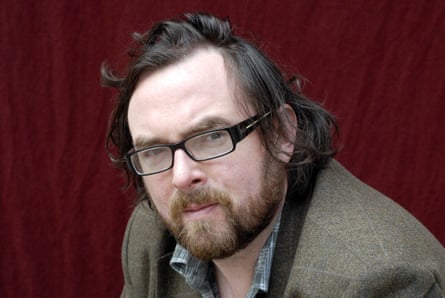As they watch a suicide bomber with explosives strapped to his chest walk through a London that feels on the brink of political collapse, some viewers may suspect that the new TV adaptation of Joseph Conrad’s novel, The Secret Agent, has been tweaked to maximise contemporary relevance.
Those elements, though, are in the original, making the BBC1 three-parter – with Toby Jones as Verloc, an anarchist who becomes involved in a plot to blow up Greenwich Observatory – the latest example of Conrad’s story becoming a prism through which modern political insecurities are viewed. It is a tactic that goes back to 1936, when Alfred Hitchcock filmed the story, under the title Sabotage, as a reflection of the developing political pressures in Europe.
Ever since, the years that sees an adaptation of The Secret Agent is unlikely to have been a good one for democracy. The BBC put the book on the screen twice in quick succession, in 1967 and 1975, straddling an era of international instability, marked by the rise of sectarian violence in Northern Ireland, student riots in France and assassinations in the US. There had even been, in the early 70s, a period of actual anarchist terrorism in England, with bombings carried out by the Angry Brigade.
When the BBC again filmed the novel in 1992, with David Suchet as Verloc, The Secret Agent again felt uncannily suited to a period of legislative turmoil and fear of terrorism: four years previously Pan Am flight 103 had exploded over Lockerbie in Scotland in a bombing attributed to Libya, and the series aired during a spell in which governments were tumbling around the world, including those of Margaret Thatcher and the first President Bush, who had been undermined by a populist drive against the political establishment led by a billionaire political outsider, Ross Perot.

The strong resonance of the novel in that epoch is shown by the fact that a movie version, written and directed by Christopher Hampton, followed in 1996, its release coming spookily soon after the apprehension by the FBI, of Ted Kaczynski, an American domestic anarchist known as the “Unabomber”. A university professor, like the character in The Secret Agent with the explosive coat, Kaczynski had used the pseudonym “Conrad”, and appears to have been an admirer of the novel.
Although no new screen version followed the 9/11 attacks, the book was regularly referenced in journalistic commentary on the atrocities. So, given this history, it is little surprise that The Secret Agent should turn up on British television in 2016, soon after terrorist attacks in France and Belgium, and in a summer when Donald Trump has become the most successful non-mainstream presidential candidate since Perot.
Conrad’s book still seems to be the fiction that best expresses western society’s concerns about terrorism and popular revolution. And, looking at the fictions on these subjects that have appeared in the subsequent 109 years, the story of Verloc has also influenced each intermittent wave of novels about terrorism, as writers responded to the threats from the IRA, Palestinian terror groups, al-Qaida and now Islamic State.
The fuse on this line of writing was lit in the first decade of the 20th century not only by The Secret Agent but by another novel about anarchists that appeared one year later in 1908: The Man Who Was Thursday by GK Chesterton. Although Conrad’s Verloc inhabited an earlier London – the Greenwich bomb plot takes place in 1886, inspired by a real incident of that time – the books draw on the same subculture of political dissent. In Chesterton’s work, a squad of anti-anarchist police attempts to infiltrate the European Council of Anarchism, whose members maintain anonymity, in a strategy similar to the use of colour-coded aliases by the robbers in Tarantino’s Reservoir Dogs, by each taking the name of a day of the week.
Another overlap between The Secret Agent and The Man Who Was Thursday is a contrast between the implications of the stories and the tone in which they are told, a distance signalled by subtitles. Conrad calls his novel “A Simple Tale”, and adopts a satirical and moralising attitude towards his characters: Verloc runs a Soho sex shop, while the anarchists with whom he consorts include one whose diet consists only of raw carrots. Categorised by Chesterton as “A Nightmare”, The Man Who Was Thursday develops into a farce of subterfuge, in which almost no one is who they claim to be or not to be. And, if Conrad saw in anarchism a chance to dramatise the worst aspects of human behaviour, Chesterton, an optimist and devout Roman Catholic believer, attempts a moral about the possibility of betterment.
For obvious historical reasons, the anarchist thriller soon enough gave way in Britain to the genre of war stories, first written by those who had served in the 1914-18 conflict, such as AP Herbert’s The Secret Battle (1919), Ford Madox Ford’s Parade’s End (1924-28) and W Somerset Maugham’s Ashenden: The British Agent (1928). Veterans of the second world war subsequently reported back in another wave of conflict fiction, including Nicholas Monsarrat’s The Cruel Sea (1951) and two American works from the same year: From Here To Eternity by James Jones and Herman Wouk’s The Caine Mutiny.
Naval war novels, such as Montsarrat’s and Wouk’s, are inevitably influenced by Conrad stories based on his career as a merchant seaman (Typhoon, Heart of Darkness), but The Secret Agent also strongly informs war literature.
When Alfred Hitchcock, in 1936, based a film on Maugham’s Ashenden, he gave it the Conradian title Secret Agent, even though he was almost simultaneously engaged in the project to turn The Secret Agent into the film that became Sabotage. But this confusion is illuminating, as there is a line of inheritance from anarchist to war literature, and, indeed, beyond that, to the next fictional growth area: espionage. The leaders in that field, Graham Greene and John le Carré, had recognisably read Conrad and Maugham.

Trails from The Secret Agent and espionage novels can then be traced into the next big burst of fiction about domestic terrorism following the outbreak of the Irish Troubles. The footprints of anarchist fiction can be found here too, as the Irish republican leader Michael Collins, a historical inspiration to the IRA, was a declared admirer of The Man Who Was Thursday, claiming to have learned from it that the best way of avoiding being hunted was not to seem to be hiding anything.
Troubles fiction began as early as 1973, when Jack Higgins (the pen name of Harry Patterson) published A Prayer for the Dying, in which the protagonist, Martin Fallon, is a former IRA killer trying to atone for his past. Higgins has also written a sequence of 21 novels since Eye of the Storm (1992), featuring Sean Dillon, a former IRA hitman.
The most enduringly praised Troubles thriller, though, has been Gerald Seymour’s Harry’s Game (1975), in which a British agent goes undercover to hunt the republican assassin of a British politician. Seymour had reported from Belfast for ITN and established the habit of fiction about Northern Irish terrorism initially being written by outsiders.
The American Paul Theroux drew on his experience of living in London during the IRA bombing campaign for The Family Arsenal (1976), based around a bombing cell in south London. Another literary immigrant, the Iranian-Rhodesian Doris Lessing, wrote The Good Terrorist (1985), a novel that seems to hold deliberate echoes of The Secret Agent, as Alice, a middle-class communist, becomes involved with a cabal of London anarchists who, inspired by the IRA, transmute into terrorists. For understandable reasons of getting enough of the subject at home – and the genuine physical risk to publishers and writers who were perceived to be taking sides – Northern Irish writers have only fully tackled the topic in books written since the establishment of the peace process, by crime writers including Adrian McKinty, Brian McGilloway and Stuart Neville.

The eruption of Catholic-Protestant violence in Northern Ireland was paralleled by increasing Israeli-Arab tension – from the six-day war of 1967 to the killing of Israeli athletes at the Munich Olympics in 1972 and the Yom Kippur war of 1973 – and there is a porous border between the literatures of Irish and Middle Eastern terrorism. Seymour followed Harry’s Game with The Glory Boys (1976), in which an Arab terrorist teams up with an IRA assassin to attempt to kill an Israeli scientist who is visiting London. Thomas Harris, later to be fabled as the creator of Hannibal Lecter, has acknowledged that watching the Olympics massacre on television inspired him to write the thriller Black Sunday (1975), in which terrorists from the Palestinian Black September movement conspire to detonate a TV airship filled with explosives over the stadium hosting the American football Super Bowl.
Whereas Davidson’s and Harris’s books favour the Israeli perspective, a general realignment in western attitudes towards the Middle East was signalled by Le Carré’s The Little Drummer Girl (1983), in which, extending the moral ambiguity that the writer had brought to his cold war spy stories, a woman working as a double agent for Israeli and Palestinian security forces is destroyed by her conflict of loyalties.
The next swell of novels about bombers featured the Islamist extremism that began with al-Qaida and now continues via the various iterations of Isis. What is striking about this subgenre of terrorism fiction, though, is the extent to which it anticipated rather than retro-dramatised events. The concept of the suicide plane bomb had been a pivotal plotline in The Better Angels, a 1979 thriller by Charles McCarry, which also featured Ibn Awad, a radical Islamist warlord who seems a shivery premonition of Osama bin Laden. As McCarry is a former CIA agent, some aspects of his storytelling may have been informed by agency wargaming.

Tom Clancy, an author who had less formal but friendly links with the security establishment, also spookily previewed 9/11 in Debt of Honour (1994), in which a 747 is flown deliberately into the Capitol building, removing most of the United States government. (Read now, Harris’s Black Sunday also feels prophetic in having imagined, more than a quarter of a century before it occurred, terrorist mass murder from the skies.)
Post-9/11, the threat coming from a state of mind rather than a single nation state became a common trope in novels, including McCarry’s Old Boys (2004), in which Ibn Awad reappears, although now seeming not the conception of Bin Laden but an inflection.
One of Bin Laden’s favoured weapons was the “clean skin” or “homegrown” terrorist, radicalised and turned against their own country. This concept is explored from very different national and literary angles in At Risk (2005), written by former MI5 boss Stella Rimington; John Updike’s novel Terrorist (2006); and Chris Cleave’s Incendiary (2005), which, with grim serendipity, was published on the day of the 7/7 attacks on the London transport system.
As state-of-mind bombings have graduated to the attempt to impose an Islamic state, mass attacks on cities have become a narrative commonplace in fiction: unlikely to sell in large quantities at transport hubs are Andy McNab’s Red Notice (2012), in which 400 passengers are taken hostage in the Channel tunnel, and Crisis, in which the UK capital is threatened with unparalleled massacre, by Frank Gardner, the BBC’s security correspondent, who is one of the few victims of terrorism (shot and seriously injured by al-Qaida sympathisers in 2004) to have written in the genre.
The characters in these novels will hope that the terrorists they are up against prove to be as incompetent or eccentric as Conrad’s Verloc and the suicide-vested professor in the book that started the form.

Comments (…)
Sign in or create your Guardian account to join the discussion